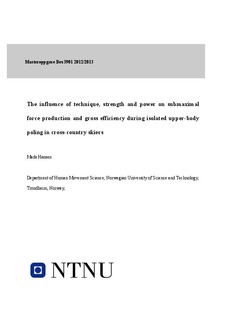| dc.description.abstract | Previous studies have shown that upper-body strength and power are associated with work economy or efficiency in various types of locomotion. However, isolated upper-body work has not yet been investigated, and the mechanisms related to these relationships have not been studied in detail. Therefore, the present study investigated gross efficiency (GE) during isolated upper-body poling, and the influence of technique, maximal strength and power on GE. Eleven male elite cross-country skiers performed three stages of 4-min submaximal poling at low, moderate and high intensity (submaximal 1, submaximal 2 and submaximal 3), and an 8-second maximal sprint using a modified poling ergometer. GE was calculated by external workrate divided by metabolic rate in submaximal stages. Poling forces were measured with a force cell, and poling displacement and velocity were measured using a motion capture system. During the submaximal tests, power per stroke (PPS) was calculated as total work produced per stroke, cycle rate (CR) as the reciprocal of the time used per cycle and poling length (PL) as the displacement of the arms during the poling movement. During the 8-sec maximal poling test, specific power was measured as the product of force and velocity averaged over the period of 8-s. Mean rate of force development (RFDmean) and rate of force development peak (RFDpeak) was measured as delta force divided by delta time (dF/dT). Furthermore 1 repetition maximum (1RM) pull-down and pull-over was measured in a pull-down apparatus. There was a linear relationship between metabolic rate and workrate, and an positive effect of workrate on GE. Specific power showed low non-significant correlations with GE, but a significant correlation with workrate in submaximal 3 (r = 0.63, p = 0.04). Furthermore, PPS during submaximal poling correlated significantly with all workrates, and GE on the submaximal 3 (all P < 0.05). 1RM pull-down and pull-over did not correlate significantly with gross efficiency in submaximal poling, but correlated significantly with workrate in submaximal 3. In conclusion, it seems like upper-body poling shows linear metabolic workrate relationships, and that most of the differences in GE can be explained by workrate differences. Furthermore, a high power per stroke seems important to obtain high workrates and high gross efficiency, whereas maximal strength and sprint power are related to the conversion of forces into power per stroke.
Key words: One repetition maximum, Double poling, specific power, Gross efficiency, Oxygen consumption. | nb_NO |
